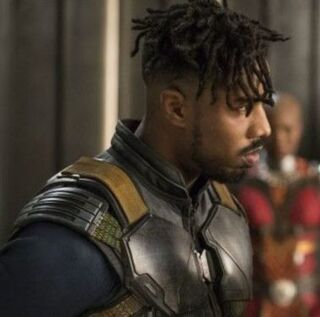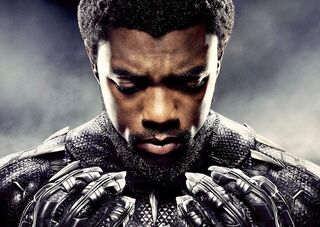Identity
The Racial Allegory of Black Panther
What does the Black Panther franchise say about contemporary racial reality?
Posted November 10, 2022 Reviewed by Abigail Fagan
We all know Black Panther as the superhero alter ego of the Wakandan king, T’Challa. In anticipation of the release of Black Panther: Wakanda Forever on November 11th, here's a look back at the original 2018 film, not to rehash T'Challa's battles, but to remind ourselves that the story of Black Panther is not only literal but also allegorical, a story of racial oppression, where each of the major (and several of the minor) characters represents a different aspect of contemporary racial reality. The full analysis (Lyubansky & Nicholson, 2021) is available elsewhere. Here, I focus on the different forms and expressions of Black identity represented by T'Challa and Killmonger.
What Is Identity and Why Does It Matter?
Identity is the way we think about ourselves. It matters because it is one of the things that determine which social groups we identify with, which, in turn, influences our sense of self-esteem (how we feel about ourselves) and self-efficacy (what we believe we are capable of doing). It matters because it influences many of our choices, including which careers we pursue, what political agenda we support, and even whom we select as friends and romantic partners. Racial identity is just a part of this, but it is an important part, especially for those who are racialized and marginalized by dominant society.
The first developmental model of Black identity was developed by psychologist William Cross in the early 1970s. Cross called his theory "Nigrescence," which translates to “the process of becoming Black.” Cross's model consists of five stages (later called “statuses”) that characterize the development of Black identity: Pre-encounter, Encounter, Immersion-Emersion, Internalization, and Commitment. These stages/statuses provide a useful framing for understanding several of the characters in the film, including Killmonger and T'Challa.
Erik Killmonger
We first meet the adult Erik Killmonger in an art museum, where he peppers the white museum director with a series of questions about ancient African artifacts. He nods at the first two answers but corrects her on the third, a mining artifact presumed to be from Benin but is actually from Wakanda.
We are made to understand that Killmonger has studied Wakandan culture and knows at least a little about the historical oppression and exploitation of Wakandans in particular and, quite likely, people of the African diaspora more generally. A few minutes later, the museum director and several guards are dead and Killmonger, Ulysses Klaue, and several other associates are celebrating their heist in the getaway van.

At this point, Killmonger’s racial identity is confusing. He is clearly aware of the historical exploitation of the African continent, which suggests that he is not in the pre-encounter stage in which individuals identify primarily with mainstream culture/society, generally lack a racial consciousness, and tend to resist racialized analysis and framing (Cross, 1971).
Killmonger is clearly engaged in a racialized analysis, but if he is against the exploitation of Africa and its people, why partner with Klaue, a person who seems interested only in exploiting Wakandan resources for his own gain? It makes little sense until Killmonger kills Klaue and uses his body to gain entry into Wakanda. A short while later, Killmonger has his audience with T’Challa, with the Wakandan elders in attendance. They scoff when he tells them he wants the throne, but Killmonger remains unperturbed:
Killmonger: Y’all sittin’ up here comfortable. Must feel good. There’s about two billion people all over the world that looks like us but their lives are a lot harder. Wakanda has the tools to liberate them all (Coogler & Cole, 2018).
Killmonger wants to wage war against the forces of oppression. He wants to liberate the two billion people that look like him, but he is willing (eager, really) to kill and oppress others to reach that goal, because he cannot imagine a world outside the dichotomy of being either the oppressor or the oppressed. As a result, it is not all people that Killmonger identifies with and holds in high regard; it is Black people, which suggests that he is most likely in the immersion-emersion stage, an identity in which almost everything is seen through a racialized lens with an unapologetic promotion of blackness, sometimes accompanied by abhorrence and active rejection of everything associated with whiteness (Cross, 1971).
T’Challa/Black Panther
For T’Challa, racial identity is more complicated than global opposition to oppression. As the Wakandan king, he also feels the responsibility of protecting his small nation and the people within it. Throughout the film, he searches for the right course of action. Should he continue the isolationist policies of his father and his father’s predecessors who opted to hide Wakanda’s resources from the rest of the world? Or should he, instead, as W’Kabi, his friend and lead Border guard, suggests, conquer Wakanda’s enemies, starting with Klaue? Before Killmonger shows up to take his throne, T’Challa opted to follow in his father’s footsteps, but after Killmonger almost takes his life and makes his agenda to destroy his oppressors clear, T’Challa realizes his father and his father’s predecessors were wrong. He tells them so when the heart-shaped herb’s medicinal powers take him to the Ancestral Plane (Coogler & Cole, 2018):
You were wrong! All of you were wrong! To turn your backs on the rest of the world. We let the fear of our discovery stop us from doing what is right. No more! I cannot stay here with you. I cannot rest while he sits on the throne. He is a monster of our own making. I must take the mantle back, I must. I must right these wrongs.
The notion of “righting wrongs” is a familiar one both in the Marvel omniverse and our own. It is a reference to justice, but a type of justice rarely referenced in the omniverse and one that is still largely unfamiliar to most readers. The comics, of course, are full of vengeance and comeuppance. Marvel has typically delivered justice in precisely that form. Sure, we have seen superheroes like Daredevil take a stand against killing, and Spidey and many others often function as super-powered police officers, incapacitating the villains and letting the courts dispense with justice. But all these heroes use violence along the way, and the reader/viewer understands that the violence at the hands of the superheroes is the only justice these villains are likely to see.

T’Challa, of course, is also a willing fighter, if that is the only way to protect the lives of the innocent. But when he tells his father that he “must right these wrongs,” it is not killing or violence that he is referring to but rather restorative justice. It is wrong, T’Challa concludes, for Wakandans to continue to turn their back on the rest of the world. Killmonger thinks it is wrong as well. But whereas Killmonger would use the Wakandan vibranium to turn the tables and oppress the oppressors, we eventually find out that T’Challa’s vision is less about violence and more about creating conditions for people to live more peacefully and more justly. He wants to reclaim the throne, not because it is rightfully his but because he recognizes that Killmonger’s version of justice is destructive and counterproductive. He wants to make things right, not for himself or even his people, but for the world. His version of justice is human interconnection and an infrastructure that allows equal opportunity for all the world’s citizens, a philosophy that places him in the commitment stage of the Cross model.
Sellers, Smith, Shelton, Rowley, and Chavous (1998) provide a different way of looking at Black identity. Their multidimensional model consists of five dimensions, including racial ideology, which refers to a person’s philosophy in regard to how they believe members of their own racial group should act. Killmonger is a Black nationalist. He believes that humanity is divided according to race and that Blacks and whites will never be able to live in harmony. He believes that the only way for Blacks to be liberated is through the destruction of their enemies and orients himself accordingly. In contrast, T’Challa appears to have a mix of oppressed-minority and humanist ideologies. The oppressed minority ideology stresses the similarities between Blacks and other oppressed groups and sees coalition building as the most effective and appropriate strategy for social change. However, we also see him embrace Ross as an ally and it appears that he believes that people should be viewed and treated as individuals rather than as representatives of a particular racial group. While some humanists de-emphasize race completely and exhibit low levels of racial centrality, T’Challa appears to find racial identity and oppression meaningful but is not willing to limit either his identity or his purpose in the world to race alone.
Conclusion
In the original Black Panther film, Killmonger has to die not because he deserves such a fate or because the world is better off without him but because he cannot see past the duality of the oppressor and the oppressed. He has to die because this dichotomous worldview of oppress or be oppressed has to die if we are to embrace T’Challa’s vision of humanity working together for the benefit of all. It is fitting then (spoiler ahead) that we see Killmonger in Wakanda Forever (in the ancestral plane) because the belief that identity groups are in inevitable competition with each other for survival and supremacy continues to influence those of us still living. Like Shuri, we all have to do the work of resisting that influence.
References
Coogler, R., & Cole, J. R. (2018). Black Panther. Transcripts Wiki. Retrieved December 14, 2019, from https://transcripts.fandom.com/wiki/Black_Panther.
Cross Jr., W. E. (1971). The Negro-to-Black conversion experience. Black world, 20(9): 13–27.
Lyubansky, M. & Nicholson, E. (2021). The Black Panther is Black. In S.C. Howard (Ed.). Why Wakanda Matters: What Black Panther Reveals About Psychology, Identity, and Communication. Dallas, TX: BenBella Books.
Nittle, N.K. (2019, May 8). Similarities between Martin Luther King Jr. and Malcolm X. ThoughtCo. https://www.thoughtco.com/similarities-between-mlk-and-malcolm-x-2834881.
Sellers, R. M., Smith, M. A., Shelton, J. N., Rowley, S. A., & Chavous, T. M. (1998). Multidimensional model of racial identity: A reconceptualization of African American racial identity. Personality and Social Psychology Review, 2(1): 18–39.




